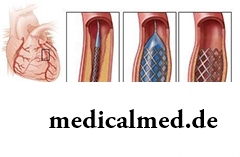





Coronary angiography
Coronary angiography of vessels: appointment and indications to carrying out
 Coronary angiography is a X-ray research of vessels of heart which is conducted for the purpose of identification of the place and extent of defeat.
Coronary angiography is a X-ray research of vessels of heart which is conducted for the purpose of identification of the place and extent of defeat.
When carrying out diagnosis for obtaining the accurate roentgenogram enter special contrast into vessels.
Appoint heart coronary angiography for diagnosis at suspicion of coronary heart disease, pains behind a breast, a heart attack, heart failure, stenocardia, an ischemic fluid lungs, ventricular disturbances of a rhythm, performing cardiopulmonary resuscitation, before surgical interventions at heart diseases.
Before making coronary angiography to the patient without fail appoint to take a blood test for the general analysis, establishment of its group, an exception of HIV, viruses of hepatitis B, C, to pass the electrocardiogram and an ekhokardiogramma. Besides the cardiologist collects the anamnesis, reveals associated diseases and their symptoms. If necessary to the patient before a research additional researches recommend to take place, appoint a course of tranquilizers, drugs against an allergy, analgetics.
Just before coronary angiography of heart carry out a local anesthesia then through an artery on a hip enter a catheter into a coronary artery and start up on it contrast which is carried on vessels and they become visible on the angiograph – the special equipment which allows to carry out large-format high-speed shooting and the subsequent computer processing of the received results. Having determined the amount of defeat of vessels, make to the patient the diagnosis and appoint treatment.
When carrying out coronary angiography of vessels the condition of the patient is watched by the anesthesiologist, the doctor-cardioresuscitator who in case of need will be able to give the emergency help to the patient. The risk of development of a complication when carrying out coronary angiography of heart is minimum, but nevertheless cases when during the procedure bleeding in the field of a puncture opened are known, the cordial rhythm was broken, thrombosis of a coronary artery, a heart attack, an allergy to contrast (an itch, puffiness, rash, trouble breathing, pressure decline, an acute anaphylaxis) developed.
In some cases the doctor after approval of the patient makes the decision to make coronary angiography along with holding medical procedures: stenting and balloon dilatation.
The patient after heart coronary angiography only one or two days since the procedure of a malotravmatichn is recovered.
Contraindications to coronary angiography
 It is impossible to make coronary angiography without the consent of the patient, the procedure is considered small operation. Coronary angiography has no serious contraindications, but it is not recommended to carry out it to patients with high temperature, anemia, long bleedings, including in the anamnesis, at disturbances of process of coagulability of blood, at the low level of potassium.
It is impossible to make coronary angiography without the consent of the patient, the procedure is considered small operation. Coronary angiography has no serious contraindications, but it is not recommended to carry out it to patients with high temperature, anemia, long bleedings, including in the anamnesis, at disturbances of process of coagulability of blood, at the low level of potassium.
With care appoint coronary angiography of vessels to elderly patients, at considerable fluctuations of weight, not cured renal failure, a diabetes mellitus, serious diseases of lungs.
Contraindication to coronary angiography is also existence of an allergy to a contrast agent therefore before operation it is desirable to pass an allergy test on the applied dye.
Besides it is necessary to consider that not only the allergy, but also a renal failure that is surely considered at inspection of patients with heart failure, a chronic renal failure, a heavy diabetes mellitus can be side effect of use of contrast on coronary angiography. This group of patients is recommended to prepare for the procedure in the conditions of a hospital.
Average life expectancy of lefthanders is less, than right-handed persons.

The varicosity has familiarly many, statistically, this disease more than a half of all adult population. As...
Section: Articles about health
Heart disease and blood vessels lead to disturbance of blood supply of bodies and fabrics that involves failures in their work, deterioration in health of the person, decrease in its working capacity and standard of living. Annually such perishes from pathologies more...
Section: Articles about health
The phenomenon of improvement of a condition of the patients at administration of drugs who are not containing active agents, so-called effect of placebo is known long ago. At the end of the 18th century the American doctor Perkins began to treat people the "miracle" sticks made of alloy of steel and brass. Was for several minutes to press such subject enough to a sore point that it became much easier for the patient. Having suspected Perkins of charlatanism, his colleagues tried to repeat "miracle" by means of sticks, steles...
Section: Articles about health
Almost each of us during life faced dissatisfaction with own body. At such moments, as a rule, we beginning...
Section: Articles about health
Doctors claim that the people not so familiar with a dorsodynia occur among adult Russians very seldom. At the same time the vast majority of the patients who are periodically testing this indisposition do not hurry to ask for medical care at all. With one St...
Section: Articles about health
You heard that laughter prolongs life? Researchers did not manage to establish longevity direct link with sincere fun yet, but several facts confirming beneficial influence of risibility on the state of health are clinically proved....
Section: Articles about health
Energy saving lamps are one of the most popular products of innovative technologies, and there is no wonder: they much эк...
Section: Articles about health
For the last decades the diabetes mellitus of the second type became really world problem. The number of cases annually increases, and average age of patients for whom the illness is diagnosed, steadily decreases. Specialists consider that one of osno...
Section: Articles about health
Maternal milk is the best food for the newborn. It is the unique natural product containing an optimum set of nutrients, and which is best adapted in order that the baby normally developed and it was protected from harmful factors of external environment, unusual for it. Unfortunately, breastfeeding process not always does without complications. Sometimes, that the kid begins to bite a breast, giving to mother an essential inconvenience. Some women...
Section: Articles about health
Ability of an organism to resist to adverse environmental factors (to impact of temperature drops, humidity and pressure...
Section: Articles about health
About influence of fasting days on an organism it is told much – both about advantages, and about shortcomings. It is considered that fasting day in the form of a short-term monodiet is useful, promoting effective removal of slags from an organism whereas irregular, it is excessive п...
Section: Articles about health
Many parents of children at the age of 2-4 years face excessively whimsical behavior of the child. The kid exhausts constant crying and whims not only the parents, but also himself. In what the reasons of children's whims. And how to fight with them?...
Section: Slideshow
The name of this disease precisely reflects the problem reason: it consists in the bra fastener pressure upon a certain zone...
Section: Articles about health
Shops of household appliances offer us the huge choice of various devices for the house. Whether there are among this abundance devices which not only facilitate house work, but also help to keep health of the person? Of course, and we will tell about them today....
Section: Articles about health
Among a set of the perfumery and cosmetic goods which are released today the special group is made by the means containing antibacterial components. Such types of gels, shampoos, soaps, creams, lotions and other products are positioned by manufacturers as a panacea from all diseases caused by pathogenic microorganisms. The unlimited and uncontrolled use of similar means becomes result of trustfulness of the buyers hypnotized by persuasive advertizing sometimes. Many spetsial...
Section: Articles about health
Food with the increased content of sugar is attractive to most of people - it is scientifically confirmed fact. Business here not in a nevozder...
Section: Articles about health
Bulimia and anorexia, are heavy deviations of a feeding behavior, become a cause of death of patients much more often than all other nervous breakdowns combined. In 60% of cases two illnesses accompany each other: patients feel horror before danger on...
Section: Articles about health
The winter swimming in open reservoirs called in our country by "winter swimming" – officially recognized sport and one of the most extreme ways of a hardening of an organism. This occupation has an old story and adherents in many countries. The international competitions in winter heats on open water, and every two years – the World Cup are annually held. Despite huge popularity and the proved advantage for health, winter swimming is still surrounded with hardy delusions. Ра...
Section: Articles about health
The unpleasant feelings connected with spring breakdown are familiar almost to each of us. Often happens that in March-April on the person...
Section: Articles about health
The sudden heat on all body which is followed by perspiration and a cardiopalmus – the phenomenon familiar to many people. Most often such states called by "inflows" result from nervous or physical overworks and disappear right after rest. Odn...
Section: Articles about health
Smack in a mouth can arise in the natural way – as a result of lack of morning hygiene or reception of the corresponding food. However in certain cases its existence is a sign of certain pathologies, and allows to reveal an illness at an early stage. Depending on character of aftertaste – acid, salty, bitter, sweet – distinguish also diseases which accompany it....
Section: Articles about health
For anybody not a secret that our country is one of the most "drinking" in the world. At clear understanding of that the use of strong...
Section: Articles about health
Aspirin (acetylsalicylic acid) – one of those drugs which are known literally to all. It is available in each home first-aid kit, and many accept it at the first signs of an indisposition, often without having a fair idea of properties and a therapeutic eff...
Section: Articles about health
Dogrose – one of the most widespread adornment and medicinal plants growing practically in all territory of our country. To most of Russians it is a beautiful bush it is known, first of all, as a source of fruits, extremely vitamin-rich. However curative properties of a dogrose are not limited to it at all. About how still it is possible to use a plant in the medical purposes, we will tell today....
Section: Articles about health
Extracorporal fertilization – one of the most modern methods of controlling with infertility. So far it already helped znach...
Section: Articles about health
Deciding to get rid of an addiction, not all imagine what effects it is necessary to face. Process of refusal of smoking causes quite essential discomfort in most of people: differences of mood, sleep disorder, fatigue, decrease физич...
Section: Articles about health
Water with a lemon - idle time in preparation drink which supporters of a healthy lifestyle already managed to appreciate. Used in a warm look and on an empty stomach, it is one of the most useful prophylactics allowing to prevent tens of diseases and just to raise an organism tone. Especially effectively to use warm water with lemon juice after a serious illness, during a season of the colds, and also to children, old men and pregnant women which do not have contraindications...
Section: Articles about health
